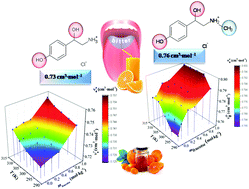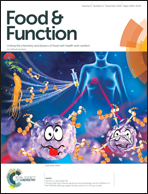The solvation properties and effect of d-fructose on the taste behavior of Citrus aurantium active components in aqueous solutions†
Abstract
The densities and viscosities of synephrine hydrochloride and octopamine hydrochloride aqueous solutions were determined. Apparent molar volumes, apparent molar volume at infinite dilution, viscosity B-coefficients and hydration number were calculated, and it was found that synephrine hydrochloride acts as a better structure maker than octopamine hydrochloride in aqueous solutions. The densities of the investigated salts were measured in aqueous D-fructose solutions, and the corresponding apparent molar volumes of transfer at infinite dilution were determined. Its taste behavior was discussed based on the calculated values for apparent specific volume and intrinsic viscosity. Molecular dynamics simulations and radial distribution functions were applied in order to understand the nature of the interactions and water structuring in the studied systems. The change in taste behavior was observed with increasing concentration of the cosolute, and it was found that the addition of sugar increases the bitterness of the solution. From a molecular docking study on the bitter receptor TAS2R38, the strongest interactions for synephrine-HCl were noted causing the most bitter taste.



 Please wait while we load your content...
Please wait while we load your content...